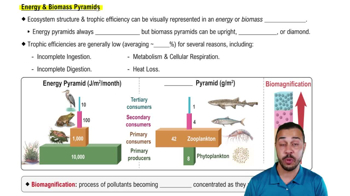Table of contents
- 1. Introduction to Biology2h 40m
- 2. Chemistry3h 40m
- 3. Water1h 26m
- 4. Biomolecules2h 23m
- 5. Cell Components2h 26m
- 6. The Membrane2h 31m
- 7. Energy and Metabolism2h 0m
- 8. Respiration2h 40m
- 9. Photosynthesis2h 49m
- 10. Cell Signaling59m
- 11. Cell Division2h 47m
- 12. Meiosis2h 0m
- 13. Mendelian Genetics4h 41m
- Introduction to Mendel's Experiments7m
- Genotype vs. Phenotype17m
- Punnett Squares13m
- Mendel's Experiments26m
- Mendel's Laws18m
- Monohybrid Crosses16m
- Test Crosses14m
- Dihybrid Crosses20m
- Punnett Square Probability26m
- Incomplete Dominance vs. Codominance20m
- Epistasis7m
- Non-Mendelian Genetics12m
- Pedigrees6m
- Autosomal Inheritance21m
- Sex-Linked Inheritance43m
- X-Inactivation9m
- 14. DNA Synthesis2h 27m
- 15. Gene Expression3h 20m
- 16. Regulation of Expression3h 31m
- Introduction to Regulation of Gene Expression13m
- Prokaryotic Gene Regulation via Operons27m
- The Lac Operon21m
- Glucose's Impact on Lac Operon25m
- The Trp Operon20m
- Review of the Lac Operon & Trp Operon11m
- Introduction to Eukaryotic Gene Regulation9m
- Eukaryotic Chromatin Modifications16m
- Eukaryotic Transcriptional Control22m
- Eukaryotic Post-Transcriptional Regulation28m
- Eukaryotic Post-Translational Regulation13m
- 17. Viruses37m
- 18. Biotechnology2h 58m
- 19. Genomics17m
- 20. Development1h 5m
- 21. Evolution3h 1m
- 22. Evolution of Populations3h 52m
- 23. Speciation1h 37m
- 24. History of Life on Earth2h 6m
- 25. Phylogeny2h 31m
- 26. Prokaryotes4h 59m
- 27. Protists1h 12m
- 28. Plants1h 22m
- 29. Fungi36m
- 30. Overview of Animals34m
- 31. Invertebrates1h 2m
- 32. Vertebrates50m
- 33. Plant Anatomy1h 3m
- 34. Vascular Plant Transport2m
- 35. Soil37m
- 36. Plant Reproduction47m
- 37. Plant Sensation and Response1h 9m
- 38. Animal Form and Function1h 19m
- 39. Digestive System10m
- 40. Circulatory System1h 57m
- 41. Immune System1h 12m
- 42. Osmoregulation and Excretion50m
- 43. Endocrine System4m
- 44. Animal Reproduction2m
- 45. Nervous System55m
- 46. Sensory Systems46m
- 47. Muscle Systems23m
- 48. Ecology3h 11m
- Introduction to Ecology20m
- Biogeography14m
- Earth's Climate Patterns50m
- Introduction to Terrestrial Biomes10m
- Terrestrial Biomes: Near Equator13m
- Terrestrial Biomes: Temperate Regions10m
- Terrestrial Biomes: Northern Regions15m
- Introduction to Aquatic Biomes27m
- Freshwater Aquatic Biomes14m
- Marine Aquatic Biomes13m
- 49. Animal Behavior28m
- 50. Population Ecology3h 41m
- Introduction to Population Ecology28m
- Population Sampling Methods23m
- Life History12m
- Population Demography17m
- Factors Limiting Population Growth14m
- Introduction to Population Growth Models22m
- Linear Population Growth6m
- Exponential Population Growth29m
- Logistic Population Growth32m
- r/K Selection10m
- The Human Population22m
- 51. Community Ecology2h 46m
- Introduction to Community Ecology2m
- Introduction to Community Interactions9m
- Community Interactions: Competition (-/-)38m
- Community Interactions: Exploitation (+/-)23m
- Community Interactions: Mutualism (+/+) & Commensalism (+/0)9m
- Community Structure35m
- Community Dynamics26m
- Geographic Impact on Communities21m
- 52. Ecosystems2h 36m
- 53. Conservation Biology24m
48. Ecology
Introduction to Ecology
Problem 8a
Textbook Question
Which statement best describes the desert biome? a. It is found wherever temperatures are high; b. It contains a larger amount of biomass per unit area than any other biome; c. Its dominant vegetation is adapted to conserve water; d. Most are located at the equator; e. It is not suitable for human habitation
 Verified step by step guidance
Verified step by step guidance1
Identify the key characteristics of a desert biome, which include low precipitation, extreme temperature variations between day and night, and adaptations to conserve water.
Evaluate each statement against these characteristics: Statement (a) focuses only on high temperatures, but deserts can also be cold; (b) is incorrect as deserts have lower biomass due to harsh conditions; (c) aligns with the adaptation strategies of desert plants; (d) is incorrect as most deserts are not located at the equator but rather at higher latitudes; (e) is misleading as humans do inhabit desert regions, though it can be challenging.
Recognize that the dominant vegetation in deserts includes cacti and other succulents which have adaptations like thick, waxy skins and the ability to store water, crucial for survival in water-scarce environments.
Conclude that the statement which correctly captures the essence of desert biome adaptations and characteristics is the one that mentions the vegetation's adaptation to conserve water.
Select the statement that best matches the adaptations and characteristics of the desert biome.
Recommended similar problem, with video answer:
 Verified Solution
Verified SolutionThis video solution was recommended by our tutors as helpful for the problem above
Video duration:
53sPlay a video:
Was this helpful?
Key Concepts
Here are the essential concepts you must grasp in order to answer the question correctly.
Desert Biome Characteristics
The desert biome is characterized by low precipitation, extreme temperature variations, and sparse vegetation. These conditions lead to unique adaptations in flora and fauna, allowing them to survive in arid environments. Deserts can be hot or cold, but they all share the common trait of limited water availability.
Recommended video:
Guided course

Characteristics of Life
Water Conservation Adaptations
Plants in desert biomes have evolved various adaptations to conserve water, such as thick, waxy cuticles, deep root systems, and specialized leaves that minimize water loss. Examples include cacti and succulents, which store water in their tissues, enabling them to thrive in harsh conditions where water is scarce.
Recommended video:

Adaptive Radiation
Biomass and Productivity
Biomass refers to the total mass of living matter in a given area, and deserts typically have lower biomass compared to other biomes like forests or grasslands. This is due to the limited availability of water and nutrients, which restricts plant growth and, consequently, the animals that depend on them for food.
Recommended video:
Guided course

Energy & Biomass Pyramids

 2:54m
2:54mWatch next
Master What is Ecology? with a bite sized video explanation from Jason Amores Sumpter
Start learningRelated Videos
Related Practice































































































